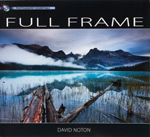David Noton explains the highs and lows of colour temperature and why simplicity is the way forward when composing images
 One of the foremost travel and landscape photographers working today, David Noton tirelessly travels the world in search of new challenges, which he shares with you here
One of the foremost travel and landscape photographers working today, David Noton tirelessly travels the world in search of new challenges, which he shares with you here
For better or for worse, I like to work with the light Mother Nature gives me. Sometimes she makes it easy for me, as in my article on Umbria, and I can capture resplendent colour and dramatic skies. At other times, such as in this scene from Snowdonia in North Wales, all the elements of nature are working against me.
This was taken very early one morning, just as the sun was coming up on an overcast day. I was stood on a hilltop overlooking the Mawddach Estuary. It was a cold morning with limited visibility, and I wanted my image to reflect these conditions.
As I always try to work with the natural light that I?m given, I don?t tend to correct colour temperature ? and the colour temperature that morning was quite high. For those unfamiliar with how colour temperatures work, the higher colour temperatures (5,000K or more) are known as ?cool? colours and appear as a blueish-white. Lower colour temperatures (2,700?3,000K), on the other hand, are called ?warm? colours and can appear as a yellowish-white up through a rich red.
I had set my Canon EOS-1Ds Mark III to its daylight white-balance setting, which recorded that morning?s cool-blue light as it actually appeared. I tend to shoot using the daylight white balance setting most of the time, as it records the most realistic version of the light that?s in front of me. At other times, I will set the white balance manually.

Some people like to correct their colour temperature or trick the camera into recording warmer colours by switching their white balance to the shade setting, which is fine ? it?s just not what I tend to do. I hardly ever adjust colour balance if I can help it.When looking at a scene, such as this one, I look at the elements and decide what?s most important. On this morning the cool-blue light was dominating the landscape so I knew I had to preserve that.
Next, I looked at the other elements of interest and decided what should be included in the frame and what didn?t deserve to be in the picture. What makes this image work for me are the shapes of the mud flats and the curves of the estuary along with the receding plains of the mountains beyond. In the low light and with its dominating blue tones, I knew these shapes had a lot of potential to make a strong graphic image.
I knew that I had to compose my image carefully if I was going to preserve the effect of these elements. I played around with the focal length and determined that going wide would take away all the impact of that mountain environment. So this for me was a case of going long. I mounted my 70-200mm zoom and settled on a focal length of 90mm. The last thing I do before I take any picture is to sweep my eye from corner to corner across the frame.
This was a picture built around one colour, with strong and bold, yet simple shapes. In my opinion, the best compositions are always the simplest. So again, I asked myself, what doesn?t deserve to be in the frame?
Your natural tendency is to go wide to include more elements in your frame, particularly if you are in a stunning place like Snowdonia where fantastic pictures can be found all around you. Yet, by going wider and incorporating more, you run the risk of muddling your composition and taking the impact away from the one subject that deserves it. If there?s one distracting thing in your composition, the entire picture loses impact. Less is definitely more.
In my case here, there was a pile of interesting rocks in the foreground where I stood, just below where I cut off my frame. In the late summer, when the colours are warmer, this might have been an appealing foreground to use. In October, though, when I shot this, there wasn?t much colour and the foreground rocks wouldn?t have brought anything to this picture apart from a possible distraction. If you practise simplicity in your compositions, your viewers will have fewer such distractions and your message will be clearer, whatever it is you are trying to photograph.
 David Noton?s new book Full Frame is now available price £25. It follows David?s journey to ten different locations around the world and gives invaluable insight into his approach and working methods. For more details, visit www.davidnoton.com
David Noton?s new book Full Frame is now available price £25. It follows David?s journey to ten different locations around the world and gives invaluable insight into his approach and working methods. For more details, visit www.davidnoton.com



